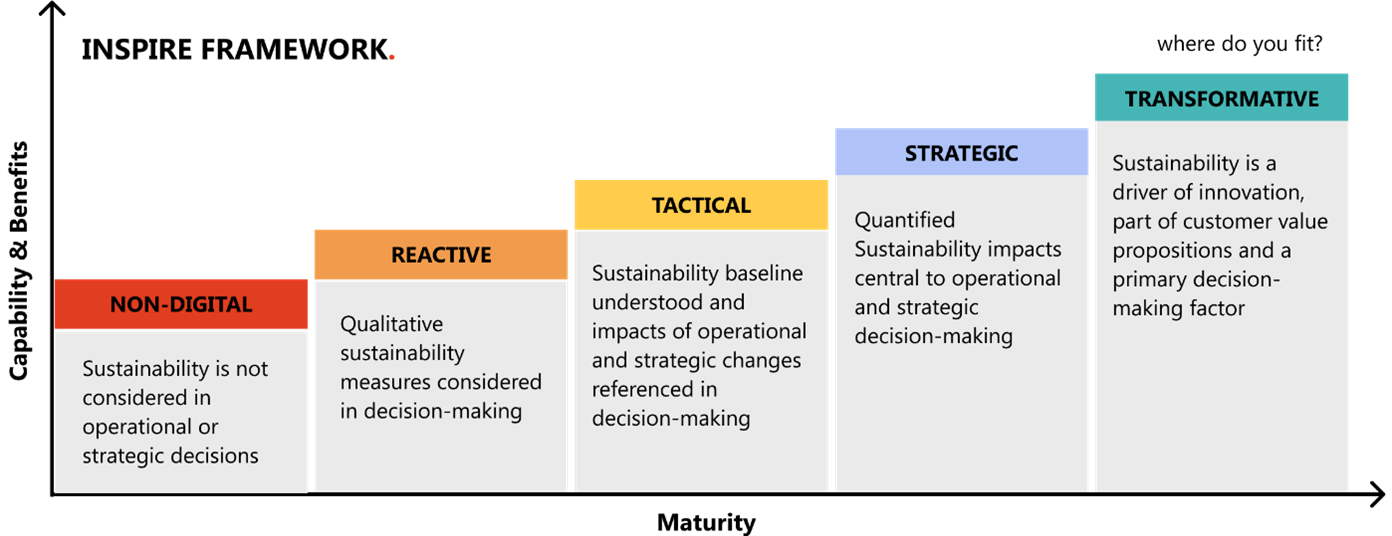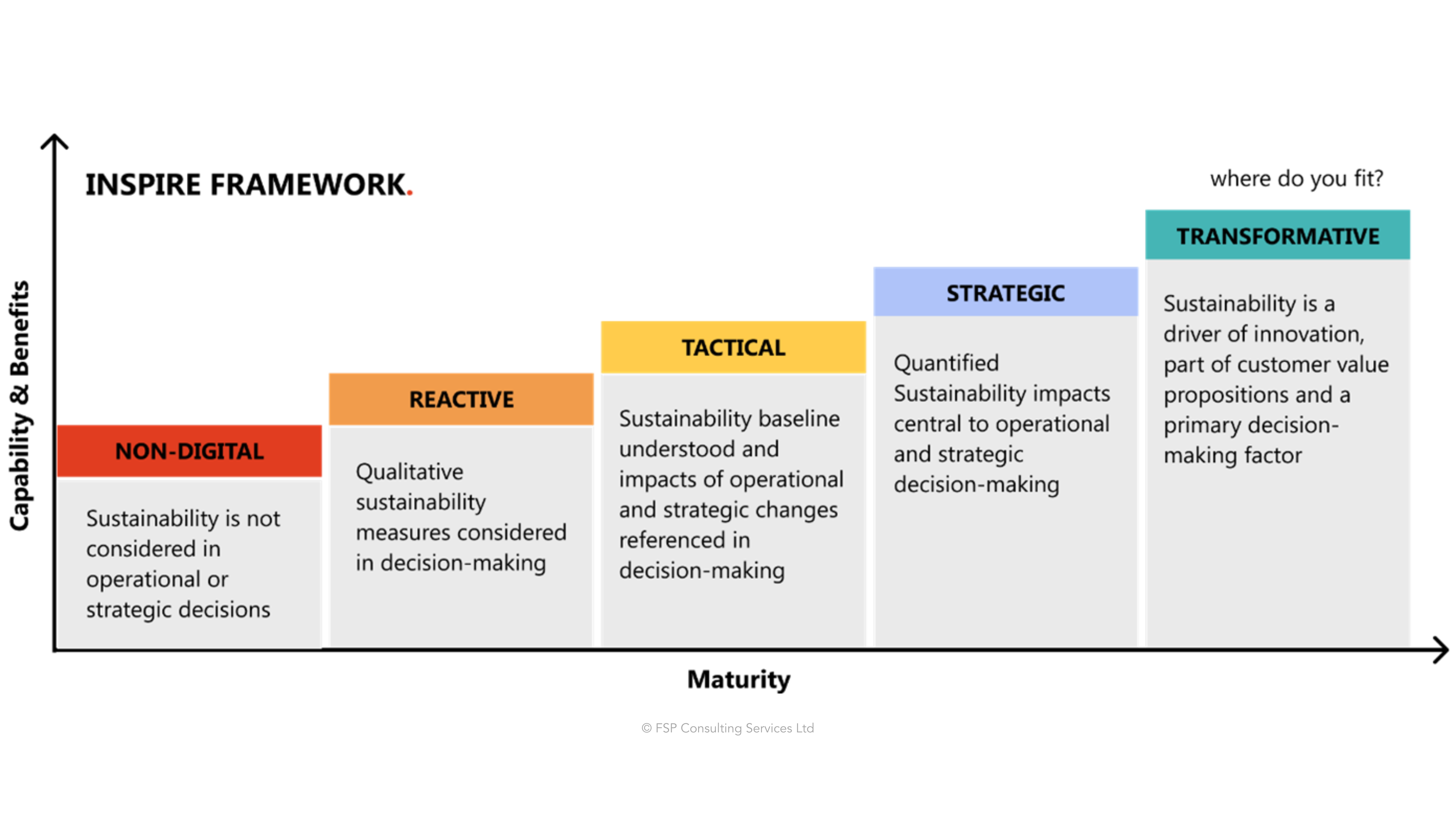This article explores the links between sustainability and digital maturity and offers some practical suggestions on how both can help you create your digital transformation strategy.
Prioritising Outcomes over Outputs
When planning your digital transformation initiative, there is a risk that one “driver”, often the catalyst for change, will carry such importance that individual outputs will be the focus rather than balanced outcomes.
At FSP, we have found that an effective approach for planning digital transformation is to think about improving digital maturity – how effective an organisation is at leveraging digital technology. By taking a holistic approach to creating your strategy, you ensure that all aspects of your organisation are considered, all the way from organisational strategy through to operating model, people, technology and data. Not only does this broad, structured approach to improving digital maturity offer the greatest chance of success for your transformation initiative, it can also ensure that your approach is sustainable.
Complementary Links
Both digital maturity and sustainability cut across all facets of an organisation, including operating model, people, technology, data and even business model. As with any activity, when implementing a digital transformation initiative, there will be an impact on the sustainability of an organisation. Likewise, being more sustainable requires organisation-wide changes and a change in mindset with regards to how technology is implemented and used. With the right approaches, sustainability and digital maturity can be complementary and help you to drive positive outcomes for your organisation and for the environment. For example, when implemented effectively, embracing cloud technology can result in increased business agility, greater opportunities for innovation as well as reducing emissions. Prioritising data analytics can help organisations meet their ESG (Environmental, Social and Governance) reporting requirements as well as establishing or maturing a capability to exploit organisational data. Driving efficiency savings through GreenOps practices will not only reduce emissions, it will also reduce costs. Conversely though, it is possible digital technology can have a negative impact on your organisation’s sustainability goals, for example, by selecting and onboarding a new supplier with energy intensive practices and limited roadmap to both report on and reduce these.
Including sustainability as part of your transformation strategy will help you drive overall digital maturity as well as helping your organisation take a significant step toward net zero. Being digitally mature will help your organisation make more effective decisions about how to sustainably leverage digital technology.
How to hard-wire sustainability into all decision making
Digital maturity is fundamentally about making effective decisions with regards to digital technology. When evaluating your organisation’s level of digital maturity, it is crucial to assess how sustainability features in the decision making process and how it informs the scoping and prioritisation of initiatives.
The scale below is from Inspire – FSP’s digital maturity assessment framework – and illustrates how sustainability moves from no consideration, to being a baselined, quantified, driver of investment and innovation that is central to all decision making as maturity increases.

© FSP Consulting Services Ltd
Our Inspire framework also considers digital maturity through a number of other lenses and allows us to review and share applicable lessons learned from across industries to help organisations assess their maturity and form strategies for successful transformation and value creation.
To help you evaluate your organisations level of digital maturity with regards to sustainability, we would recommend you initially focus on three areas:
Governance & Assurance
Do your project / programme templates have dedicated sections to detail the impacts on sustainability?
If you review your documentation (e.g. Project Initiation Documents or Change Request Proformas) are there specific sections, with guidance, that ensures impacts on sustainability are consistently considered?
Working with your central governance teams (e.g. Programme / Transformation Management Office) you can make an immediate step forward just by ensuring that sustainability is considered from the outset. Ideally this would be a quantitative approach that looks at the measured impact in emissions against your baseline, but many organisations will not have a clear baseline or approach to measurement. A simple qualitative assessment that outlines whether the proposed change is estimated to have a perceived positive or negative impact on sustainability is the first step. Our recent white paper on sustainable digital transformation provides some pragmatic advice on what you should be considering to help answer this question.
Option Selection & Prioritisation
When shortlisting business or technical solution options to address your problem statement, is sustainability directly considered?
If you review your evaluation criteria for business cases, investment and procurement, is sustainability a direct factor in down-selection?
Working with your investment group, procurement and enterprise architecture teams you can take another step forward by directly considering sustainability in evaluation criteria. To begin with this could be a purely qualitative assessment or go all the way through to attaching a financial value to the emissions / carbon impact and directly “monetising” the assessment alongside costs and benefits.
Portfolio Definition
Is sustainability a strategic priority that drives innovation, investment, projects and programmes?
If you review your company’s strategic goals, is there a specific, measurable and time-bound objective related to sustainability, e.g. we will reduce emissions by 40% by 2027?
Working with your executive team and strategic leaders and gaining commitment to a measurable goal will create the imperative for action. In many cases the first step will be baselining your current emissions to understand the scale of the challenge. This will drive innovation, new ways of working and in many cases the definition of projects and programmes to support understanding and reduction!
Conclusion
Digital transformation should not be seen as delivering one particular technology or output, instead it should be seen as improving the holistic digital maturity of an organisation. Sustainability offers the opportunity to further enhance and accelerate that maturity thereby increasing the chances that your transformation initiative will not only be a success, it will also be sustainable.
Sustainability and the many impacts and considerations it introduces can be overwhelming and it can be difficult to know where to start. By assessing your practices and processes around governance & assurance, option selection & prioritisation, and portfolio definition, you can evaluate the maturity of your organisation’s decision making process when it comes to sustainability. By prioritising improvements to this decision making process as part of your strategy, you can start to drive greater levels of digital maturity and suitability.
Partnering with FSP for a Sustainable Future
If you want to explore other enablers for achieving sustainable digital transformation, we invite you to check out our white paper which also contains pragmatic advice for digital leaders looking to find out more about sustainability and how it can benefit their transformation initiatives. Feel free to get in touch with us at sustainability@fsp.co to find out more about these topics and discuss how we can help your organisation thrive in the realm of sustainability.

